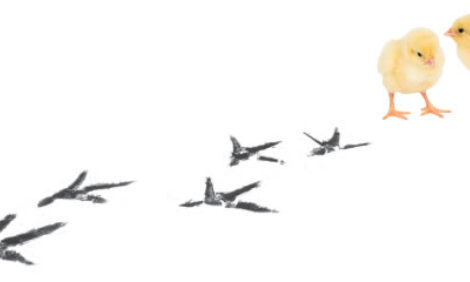



Maximising uniformity through top-level hatchery practice
By Ir Lotte van de Ven, Pas Reform Hatchery Technologies - The greatest challenge for modern hatchery is to achieve uniform, high vitality flocks of day old chicks. Next to incubation technology, good hatchery management can greatly influence this. Uniformity is an important issue for a hatchery, and the use of good hatchery management practices can make a valuable and lasting contribution, from the hatchery right through to farm level.
Traditionally, the emphasis on uniformity of broiler chicks has been dictated by the last part of the production chain. The automated slaughtering process demands uniformity of product entering the processing plant. Often, achieving uniformity is regarded as the broiler farmer’s job and indeed, uniformity of broilers at slaughter weight can be greatly influenced by what happens on the broiler farm. As chick uniformity is unlikely to increase during the production process, a key prerequisite to a uniform end product is uniformity in the day olds. Day-old flocks showing poor uniformity are impossible to manage properly, which will result in lower growth, increased feed conversion and higher mortality during the first week.
Flock uniformity
Flock uniformity - particularly during the
first week - is an important issue for management
because at the moment of hatching,
a number of physiological systems are
still developing in the chick, and this
process continues during the first seven to
ten days of life. Amongst these systems is
the thermoregulatory system. During the
first days of their lives, newly hatched
chicks have little or no ability to regulate
their body temperature. This means that as
environmental temperature decreases, the
internal temperature of the chick is also
reduced - and as small chicks have a higher
surface to volume ratio, they lose more
heat than large chicks.
Consequently,
small chicks may benefit from an environmental
temperature that is 2°C higher
than large chicks. Furthermore, an air temperature
that is too cool will prevent
chicks from getting adequate feed and
water. To conserve warmth, birds respond
by huddling together but are then unable
to get to feeder lids and drinkers.
Next to the development of thermoregulation,
the complete development of the digestive
tract and immune system is equally
important. Maturation of the digestive and
immune systems depend, in the first few
days, on the chick getting all the nutrients
and antibodies provided by the yolk sac. As
the uptake of nutrients from the yolk is
stimulated by the intake of feed, the development
and growth of the newly hatched
chick relies on having almost immediate
access to feed and water.
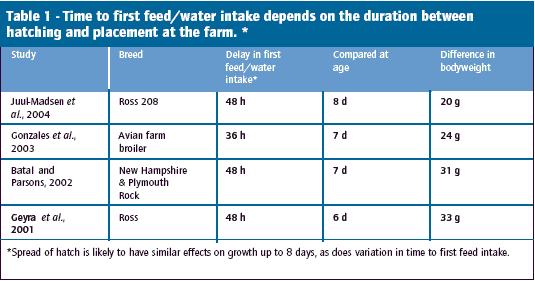
During the brooding period, the chick is
highly dependent on its environment.
Good management, especially during the
first days of a chick’s life, is crucial to maximise
performance and liveability. In order
to realise optimum environmental conditions
and feed/water supply for a maximum
number of chicks, uniformity of dayolds
is a prerequisite.
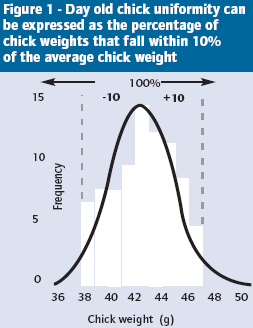 Next to providing optimum
conditions, having chicks separated
by size may reduce competition within the
flock, decrease mortality, increase growth
rate and improve uniformity of marketing
weight when the birds enter the processing
plant. Uniformity of day olds is therefore
highly valued by the farmer-customer.
Next to providing optimum
conditions, having chicks separated
by size may reduce competition within the
flock, decrease mortality, increase growth
rate and improve uniformity of marketing
weight when the birds enter the processing
plant. Uniformity of day olds is therefore
highly valued by the farmer-customer.
DOC uniformity
There appears to be general consensus
about the importance of chick uniformity.
However, some confusion arises when it
comes to the question of measuring uniformity.
Poultry growers generally assess the
uniformity of a flock ‘by eye’ – though in
general terms, information regarding practical
standards for measuring the uniformity
of day-olds is lacking. In broiler production,
uniformity is expressed as the
percentage of birds whose weight falls
within 10% of the flock’s average weight -
and current industry standards dictate
that to achieve good uniformity, 80-85% of
birds must fall within 10% of the average
flock weight. In day-olds, it is possible to
achieve 100% uniformity based on this
standard; hence this range may reasonably
be narrower than 10% for newly hatched
chicks (Figure 1).
For the purpose of this article, we will
take chick weight as a measure for uniformity
and focus on aspects of hatchery
management that affect the range of
weights in day old chicks.
Spread of hatch
Variation in day old chick body weight at
the moment of placement in the farm may
be much higher than the variation of newly
hatched chicks. The weight of chicks at
placement is affected by their weight at
hatch and the length of time they are held
in the hatcher. Chicks that have to wait in
the incubator for prolonged periods dehydrate
and lose weight. Spread in chick
weights upon placement - and thus uniformity
- is consequently influenced by the
spread of hatch.
Regarding spread of hatch, numerous
studies have investigated the effects of a
delayed access to water and feed for day
old chicks. Time until first feed/water intake
depends on the duration between
hatching and placement at the farm.
Spread of hatch within a batch of chicks in
one hatcher causes variation in the time at
which first feeds can be made available.
Thus, spread of hatch is likely to have similar
effects to variations in the time taken
to first feed intake, as measured in the
studies shown in Table 1.
The table summarizes recent results
from these studies, and clearly demonstrates
a negative effect on body weight at
eight days of age. The delay in feed/water
intake was shown to negatively influence
body weight up to slaughter age.
Differences in body weight were significant
when the spread in the time of access
to feed and water was more than 24 hours.
In multi-stage incubation, the hatching
process may take two days, and chicks are
removed from the incubator only when a
majority have hatched. From the results
shown above, we may conclude that chickens
hatched early will indeed show different
growth rates to late hatches up to
slaughter age.
Spread of hatch depends on equal development
of the embryos at the start of incubation,
combined with uniform rates of development
in the eggs within one incubator.
A number of factors are summarised
below, that are known to affect the spread
of hatch.
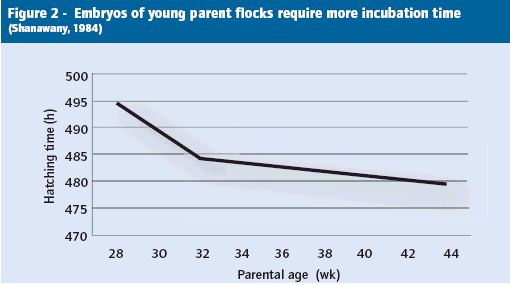
Maternal age
Maternal age influences day old chick weight through its effect on egg weight. On average, day old chicks weigh 67-76% of the initial egg weight. This is a considerable range, and although the influence of egg weight on chick weight is obvious, there are other important, influential factors that must be taken into consideration. Maternal age also directly affects the rate of embryonic development. It seems that at the moment of oviposition, the eggs of ‘mature’ flocks (>32 weeks) contain embryos in a more advanced state that develop at a higher rate than embryos in eggs from ‘pubescent’ flocks. Consequently, embryos in eggs from the latter group require longer incubation periods. Some studies even report a decrease in incubation time of up to 10 hours between 28 and 32 weeks of maternal age! (Figure 2).
Egg storage
Storage time prior to incubation is known
to influence the rate of embryonic development.
In stored eggs, the initiation of embryonic
development is delayed, and the
rate of development is also lower. Recently,
a study from the University of Leuven
(2003) confirmed the hatchery man’s rule,
that “one day storage adds one hour to in-
cubation time”, and indeed, embryos from
Cobb eggs stored for 18 days required an
additional 16 hours of incubation time,
compared to embryos from eggs stored for
three days. Incubating fresh and stored
eggs in one incubator thus increases
spread of hatch by one hour per additional
storage day!
It is important to realise that storage conditions
also have an impact on the rate of
embryonic development during incubation.
After oviposition, the temperature inside
the egg falls rapidly below the physiological
zero: the minimum temperature
above which embryonic development occurs.
However, temperatures below this
point influence other egg characteristics
too, thereby affecting egg quality - depending
on the duration of storage. Ruiz and
Lunam (2002) demonstrated a retardation
in embryonic development measured in incubation
time in eggs that were stored at
10°C for 9-11 days, compared to eggs that
were stored at 16.5°C: chicks that hatched
from the ‘cold’ stored eggs, required significantly
more incubation time.
Storage begins at the moment of laying.
Especially during the summer or in hot climates,
the time that eggs are held in the
breeder house should be minimised. In order
to maximise uniformity of embryonic
development, frequent collection of hatching
eggs is recommended.
Temperature
Naturally, a homogenous incubation temperature
during the entire incubation cycle
is fundamental to equal embryonic development,
as temperature directly affects
the rate of development in the embryo.
Normal embryonic development occurs between
37°C (98.6°F) and 38°C (100.4°F), but
the rate of development differs within this
range. Turkey embryos have been shown to
hatch approximately four hours earlier
when incubated at 37.5°C compared to
37°C (Christensen, 2001).
Of particular concern for a small spread
of hatch, is an even start of embryonic development.
A homogenous temperature for
all eggs within one incubator at the start
of incubation is fundamental to uniform
development for the batch. In this respect,
it is important to realise that batches of
eggs may require different heat-up times
to reach incubation temperature: for example,
because of different storage or transport
temperatures, or differences in egg
size. Consequently, incubating eggs of different
backgrounds may cause differences
in incubation times.
Optimise uniformity
Uniformity of day old chicks is a priority
for both hatcheries and their customers,
because improved chick management will
not only improve growth rates, but also decrease
losses from natural mortality or
culling.
The following is a useful summary of key
aspects of hatchery management that will
promote optimum chick uniformity:
Sort eggs. First, take flock age into account. The age of the mother flock affects egg size and furthermore, maternal age influences the development rate of the embryos (Figure 3). Eggs of young mother flocks (<32 weeks of age) require longer incubation time. Secondly, consider storage time. Eggs in one incubator should be of approximately the same age (storage time), since storage also retards embryonic development. For every storage day after three days, increase incubation time by ± 1 hour.
Pre-heating. Accurately sorting eggs prior to incubation enhances uniformity of embryonic development at the start of incubation. A uniform start may be further improved by pre-heating treatments prior to incubation. Eggs of various backgrounds may require different times to reach incubation temperature. Heating the eggs for several hours to 21- 25ºC reduces the variation of temperatures inside the eggs at the start of incubation (Figure 4). This will promote better uniformity of development in eggs within one machine and further reduce spread of hatch.
Homogeneous incubation temperature. Incubation temperature influences the rate of embryonic development - and crucially, homogeneous incubator temperature is required to achieve the narrowest spread of hatch. This means that incubators must be designed such that they provide uniform incubation conditions to support equal, synchronised embryonic development for each individual egg within the machine. The incubator should be divided into small, separate units, each with its own climate control. Supporting the natural pattern of the embryo and eggshell temperature during each phase of embryonic development means that optimum conditions vary during the incubation process. Consequently, optimum conditions for uniform incubation can only be achieved in single stage incubation.
Conclusion
A large spread in hatching time, and consequently in the duration to first feed/water intake, causes poor uniformity of day olds, which complicates farm management and undermines performance and results. Minimising spread of hatch is crucial for optimum results. There are two criteria that must be met for a uniform hatch:
- The hatching eggs entering the incubator must be uniform.
- During both the setting and the hatching period, the rate of development of each egg in the batch must be synchronised by a homogeneous incubation temperature .
The hatchery management methods
summarised here can greatly improve
day old chick uniformity. Application
in hatchery practice requires good
planning and the use of highly evolved
incubation technology, to assist and
maximise uniform embryonic
development.
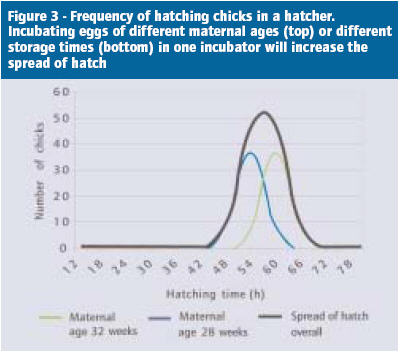
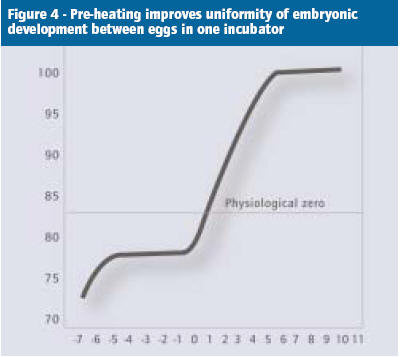
Source: Pas Reform - November 2005







